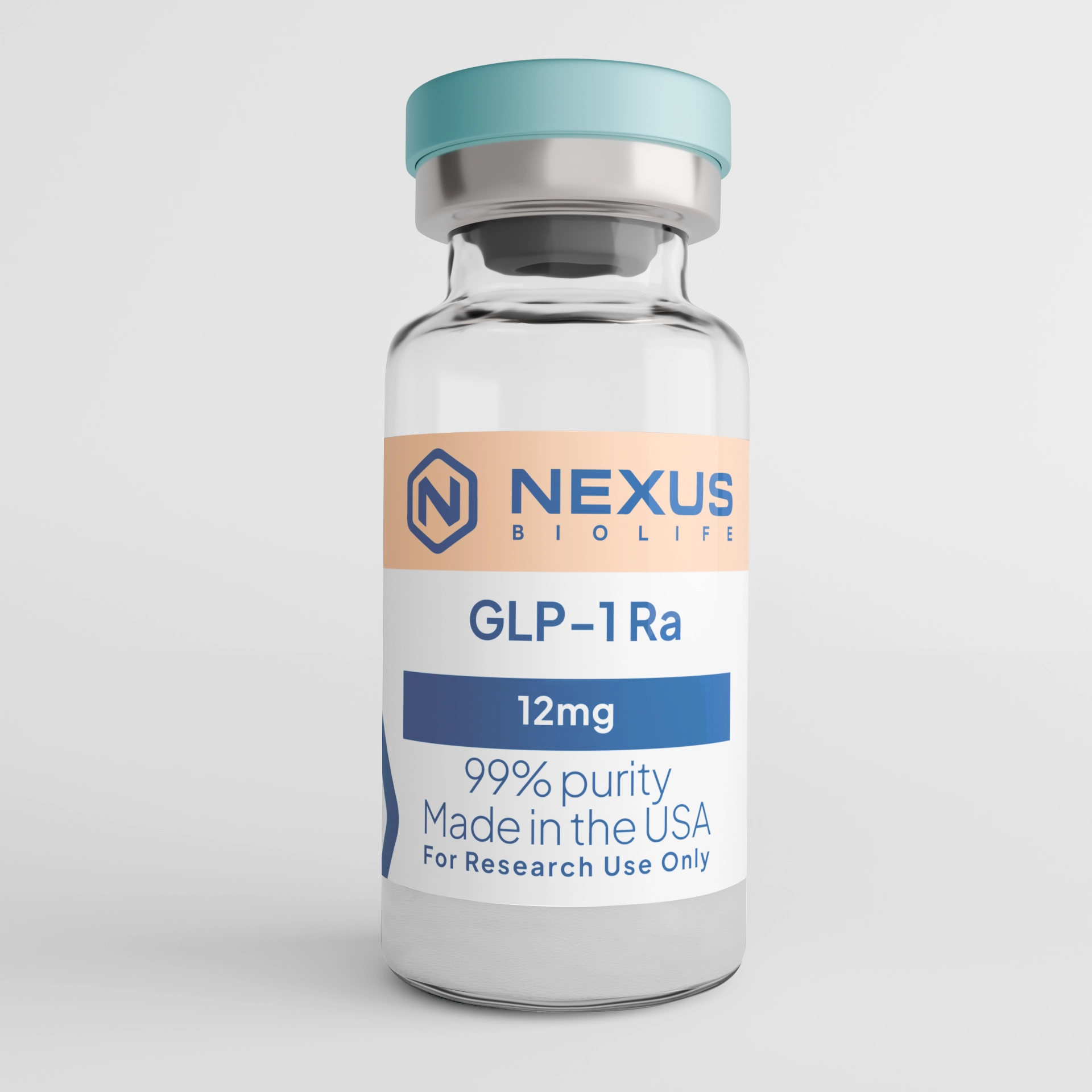
GLP-1 Ra is a synthetic peptide meticulously prepared for scientific inquiry. This product is synthesized with high purity. It is utilized in various laboratory investigations. GLP-1 Ra is designated solely for research and development purposes.

GLP-1 Ra's structure is based on a 39-amino-acid sequence: Y-Aib-Q-G-T-F-T-S-D-Y-S-I-MeL-L-D-K-K(acyl)-A-Q-Aib-A-F-I-E-Y-L-L-E-G-G-P-S-S-G-A-P-P-P-S-NH2, where Aib represents 2-aminoisobutyric acid, MeL is 2-methylleucine, and the lysine at position 17 is acylated with a C20 fatty diacid via a linker consisting of 2-[2-(2-aminoethoxy)ethoxy]acetic acid (AEEA) and gamma-glutamic acid. This fatty diacid conjugation promotes albumin binding, extending the peptide's half-life to approximately 6 days in experimental models, which supports sustained activity in assays requiring prolonged exposure. The molecular formula is C221H342N46O68, with a calculated molecular weight around 4,813 Da, reflecting its size and modifications.
These structural tweaks, including non-natural amino acids like Aib and MeL, enhance resistance to enzymatic degradation while optimizing receptor interactions—GLP-1 Ra adopts a continuous alpha-helical conformation, with the N-terminal region penetrating the receptor's transmembrane domain and the C-terminal interacting with extracellular elements. In lab practice, it's provided as a lyophilized powder with purity exceeding 98%, verified by HPLC and mass spectrometry. It shows good solubility in aqueous buffers at neutral pH, but we suggest testing small aliquots first to confirm stability in your specific setup. Our transparency in sourcing and testing ensures you get a consistent product for reliable data.
GLP-1 Ra is a synthetic 39-amino-acid peptide designed as a triple receptor agonist, targeting the glucagon-like peptide-1 (GLP-1), glucose-dependent insulinotropic polypeptide (GIP), and glucagon (GCG) receptors to investigate metabolic regulation in research models. Engineered with specific modifications for enhanced stability and potency, it mimics and amplifies the actions of endogenous hormones involved in energy homeostasis, making it a powerful tool for in-vitro studies on obesity, glucose control, and related pathways. As with all our peptides, GLP-1 Ra is supplied exclusively for research purposes and in-vitro use only—not for human consumption or any clinical applications.
GLP-1 Ra functions through balanced agonism at GLP-1, GIP, and GCG receptors, with relative potencies of 0.4-fold at GLP-1R, 8.9-fold at GIPR, and 0.3-fold at GCGR compared to native ligands. This triple activation synergistically modulates energy balance: GLP-1 and GIP components enhance insulin secretion, suppress appetite, and slow gastric emptying, while GCG agonism boosts energy expenditure and lipolysis, counterbalanced to avoid excessive gluconeogenesis. Structural insights reveal conserved interactions like salt bridges and hydrophobic contacts across receptors, with receptor-specific features—such as additional salt bridges in GLP-1R and unique stacking in GCGR—explaining its differential potency.
In cellular models, it triggers cAMP signaling pathways, leading to reduced food intake simulations and improved glucose homeostasis without standalone hyperglycemic risks from glucagon. The complementary mechanisms—where GLP-1/GIP inhibit glucagon's glucose-raising effects while amplifying its metabolic benefits—make GLP-1 Ra ideal for probing multi-hormone crosstalk in metabolic networks. We're passionate about clarifying these intricacies; GLP-1 Ra offers a logical lens into how integrated receptor signaling can drive profound metabolic shifts in controlled environments.
In summary, GLP-1 Ra stands as an innovative triple-agonist peptide, harnessing GLP-1, GIP, and GCG receptor pathways to illuminate complex metabolic interactions and advance research in obesity and diabetes models. Its engineered structure and synergistic mechanisms offer researchers a robust platform for generating insightful data, all backed by our dedication to quality and education. Exclusively for in-vitro use, GLP-1 Ra reflects our commitment to fostering scientific progress with approachable expertise and unwavering integrity. Let's partner in uncovering the next layers of metabolic science, one thoughtful investigation at a time.
GLP-1 Ra's multi-receptor profile positions it as a key asset in in-vitro and ex-vivo research on obesity, type 2 diabetes, and cardiometabolic health. In cell-based assays using receptor-expressing lines, it has been used to study dose-dependent cAMP accumulation and downstream effects on insulin release, glucagon suppression, and energy expenditure markers. Mutagenesis experiments highlight how specific residues influence binding affinity, providing insights into receptor selectivity and agonist design.
In metabolic models, GLP-1 Ra facilitates investigations into weight regulation pathways, demonstrating superior effects on lipid profiles, glucose levels, and inflammatory markers compared to single or dual agonists in simulated conditions. Research has explored its potential in reverting prediabetic states by normalizing glycated hemoglobin and fasting insulin in tissue cultures. Additionally, it's applied in studies of cardiovascular risk factors, where it modulates blood pressure and cholesterol dynamics through receptor-mediated mechanisms. We encourage using it in combination assays with other metabolic agents to uncover synergies, and our team can offer tips on optimizing protocols for these explorations—always prioritizing safety and precision in your lab.
For best results with GLP-1 Ra, store the lyophilized powder at -20°C or below in a desiccated, light-protected container to preserve its structural integrity and prevent degradation. Reconstitute with sterile bacteriostatic water or a neutral buffer to concentrations of 1-5 mg/mL, using gentle swirling to avoid foaming that could disrupt the helix or fatty acid linkage. Given its extended half-life, reconstituted solutions can be aliquoted and frozen, but we recommend fresh preparations for assays to ensure maximal activity.
Monitor for any pH shifts during handling, as extremes may affect receptor-binding efficacy. Our quality assurance includes stability testing under various conditions, so you can trust it holds up in your experiments. If you have questions about compatibility with your buffers or equipment, reach out—we're here to provide rational, evidence-based guidance.
GLP-1 Ra is a synthetic 39-amino-acid peptide designed as a triple receptor agonist, targeting the glucagon-like peptide-1 (GLP-1), glucose-dependent insulinotropic polypeptide (GIP), and glucagon (GCG) receptors to investigate metabolic regulation in research models. Engineered with specific modifications for enhanced stability and potency, it mimics and amplifies the actions of endogenous hormones involved in energy homeostasis, making it a powerful tool for in-vitro studies on obesity, glucose control, and related pathways. As with all our peptides, GLP-1 Ra is supplied exclusively for research purposes and in-vitro use only—not for human consumption or any clinical applications.
GLP-1 Ra functions through balanced agonism at GLP-1, GIP, and GCG receptors, with relative potencies of 0.4-fold at GLP-1R, 8.9-fold at GIPR, and 0.3-fold at GCGR compared to native ligands. This triple activation synergistically modulates energy balance: GLP-1 and GIP components enhance insulin secretion, suppress appetite, and slow gastric emptying, while GCG agonism boosts energy expenditure and lipolysis, counterbalanced to avoid excessive gluconeogenesis. Structural insights reveal conserved interactions like salt bridges and hydrophobic contacts across receptors, with receptor-specific features—such as additional salt bridges in GLP-1R and unique stacking in GCGR—explaining its differential potency.
In cellular models, it triggers cAMP signaling pathways, leading to reduced food intake simulations and improved glucose homeostasis without standalone hyperglycemic risks from glucagon. The complementary mechanisms—where GLP-1/GIP inhibit glucagon's glucose-raising effects while amplifying its metabolic benefits—make GLP-1 Ra ideal for probing multi-hormone crosstalk in metabolic networks. We're passionate about clarifying these intricacies; GLP-1 Ra offers a logical lens into how integrated receptor signaling can drive profound metabolic shifts in controlled environments.
In summary, GLP-1 Ra stands as an innovative triple-agonist peptide, harnessing GLP-1, GIP, and GCG receptor pathways to illuminate complex metabolic interactions and advance research in obesity and diabetes models. Its engineered structure and synergistic mechanisms offer researchers a robust platform for generating insightful data, all backed by our dedication to quality and education. Exclusively for in-vitro use, GLP-1 Ra reflects our commitment to fostering scientific progress with approachable expertise and unwavering integrity. Let's partner in uncovering the next layers of metabolic science, one thoughtful investigation at a time.
GLP-1 Ra's structure is based on a 39-amino-acid sequence: Y-Aib-Q-G-T-F-T-S-D-Y-S-I-MeL-L-D-K-K(acyl)-A-Q-Aib-A-F-I-E-Y-L-L-E-G-G-P-S-S-G-A-P-P-P-S-NH2, where Aib represents 2-aminoisobutyric acid, MeL is 2-methylleucine, and the lysine at position 17 is acylated with a C20 fatty diacid via a linker consisting of 2-[2-(2-aminoethoxy)ethoxy]acetic acid (AEEA) and gamma-glutamic acid. This fatty diacid conjugation promotes albumin binding, extending the peptide's half-life to approximately 6 days in experimental models, which supports sustained activity in assays requiring prolonged exposure. The molecular formula is C221H342N46O68, with a calculated molecular weight around 4,813 Da, reflecting its size and modifications.
These structural tweaks, including non-natural amino acids like Aib and MeL, enhance resistance to enzymatic degradation while optimizing receptor interactions—GLP-1 Ra adopts a continuous alpha-helical conformation, with the N-terminal region penetrating the receptor's transmembrane domain and the C-terminal interacting with extracellular elements. In lab practice, it's provided as a lyophilized powder with purity exceeding 98%, verified by HPLC and mass spectrometry. It shows good solubility in aqueous buffers at neutral pH, but we suggest testing small aliquots first to confirm stability in your specific setup. Our transparency in sourcing and testing ensures you get a consistent product for reliable data.

GLP-1 Ra's multi-receptor profile positions it as a key asset in in-vitro and ex-vivo research on obesity, type 2 diabetes, and cardiometabolic health. In cell-based assays using receptor-expressing lines, it has been used to study dose-dependent cAMP accumulation and downstream effects on insulin release, glucagon suppression, and energy expenditure markers. Mutagenesis experiments highlight how specific residues influence binding affinity, providing insights into receptor selectivity and agonist design.
In metabolic models, GLP-1 Ra facilitates investigations into weight regulation pathways, demonstrating superior effects on lipid profiles, glucose levels, and inflammatory markers compared to single or dual agonists in simulated conditions. Research has explored its potential in reverting prediabetic states by normalizing glycated hemoglobin and fasting insulin in tissue cultures. Additionally, it's applied in studies of cardiovascular risk factors, where it modulates blood pressure and cholesterol dynamics through receptor-mediated mechanisms. We encourage using it in combination assays with other metabolic agents to uncover synergies, and our team can offer tips on optimizing protocols for these explorations—always prioritizing safety and precision in your lab.
For best results with GLP-1 Ra, store the lyophilized powder at -20°C or below in a desiccated, light-protected container to preserve its structural integrity and prevent degradation. Reconstitute with sterile bacteriostatic water or a neutral buffer to concentrations of 1-5 mg/mL, using gentle swirling to avoid foaming that could disrupt the helix or fatty acid linkage. Given its extended half-life, reconstituted solutions can be aliquoted and frozen, but we recommend fresh preparations for assays to ensure maximal activity.
Monitor for any pH shifts during handling, as extremes may affect receptor-binding efficacy. Our quality assurance includes stability testing under various conditions, so you can trust it holds up in your experiments. If you have questions about compatibility with your buffers or equipment, reach out—we're here to provide rational, evidence-based guidance.
